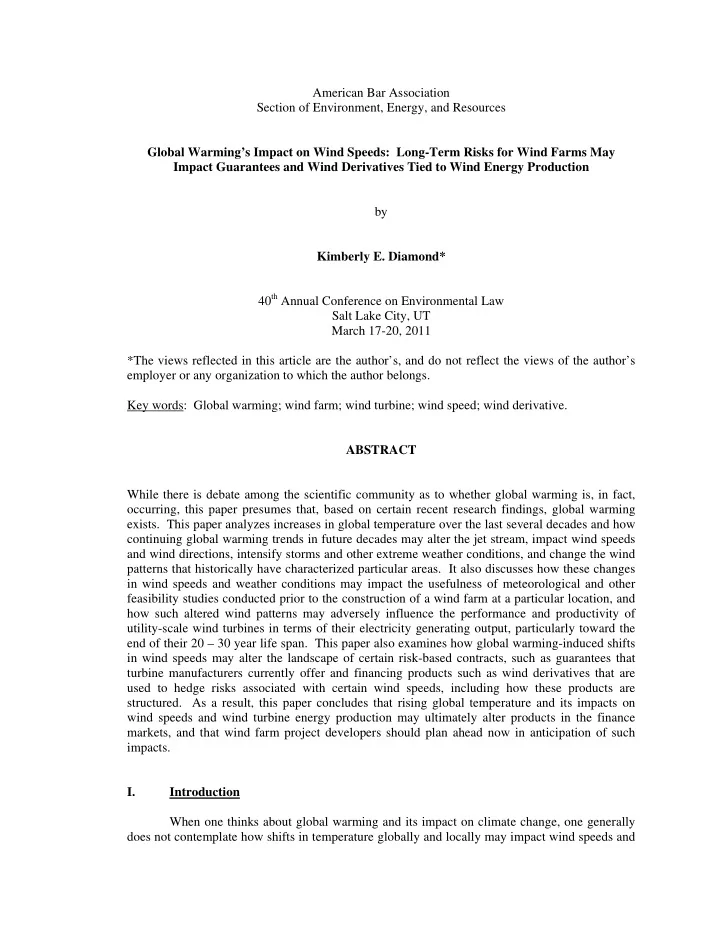

American Bar Association Section of Environment, Energy, and Resources Global Warming’s Impact on Wind Speeds: Long-Term Risks for Wind Farms May Impact Guarantees and Wind Derivatives Tied to Wind Energy Production by Kimberly E. Diamond* 40 th Annual Conference on Environmental Law Salt Lake City, UT March 17-20, 2011 *The views reflected in this article are the author’s, and do not reflect the views of the author’s employer or any organization to which the author belongs. Key words: Global warming; wind farm; wind turbine; wind speed; wind derivative. ABSTRACT While there is debate among the scientific community as to whether global warming is, in fact, occurring, this paper presumes that, based on certain recent research findings, global warming exists. This paper analyzes increases in global temperature over the last several decades and how continuing global warming trends in future decades may alter the jet stream, impact wind speeds and wind directions, intensify storms and other extreme weather conditions, and change the wind patterns that historically have characterized particular areas. It also discusses how these changes in wind speeds and weather conditions may impact the usefulness of meteorological and other feasibility studies conducted prior to the construction of a wind farm at a particular location, and how such altered wind patterns may adversely influence the performance and productivity of utility-scale wind turbines in terms of their electricity generating output, particularly toward the end of their 20 – 30 year life span. This paper also examines how global warming-induced shifts in wind speeds may alter the landscape of certain risk-based contracts, such as guarantees that turbine manufacturers currently offer and financing products such as wind derivatives that are used to hedge risks associated with certain wind speeds, including how these products are structured. As a result, this paper concludes that rising global temperature and its impacts on wind speeds and wind turbine energy production may ultimately alter products in the finance markets, and that wind farm project developers should plan ahead now in anticipation of such impacts. I. Introduction When one thinks about global warming and its impact on climate change, one generally does not contemplate how shifts in temperature globally and locally may impact wind speeds and
wind farms in the long-term. This needs to change. New research findings indicate that global warming may alter the jet stream, either increase or decrease the average wind speeds in particular locations, and cause certain areas to experience more brutal or violent weather conditions with corresponding increased turbulence and wind speeds (“Global Warming Research”). Before a utility-scale wind farm is erected, the potential developer conducts extensive feasibility studies to gauge wind speeds, wind direction, the consistency or intermittency of wind flow over a given parcel, and to use findings from these studies to ultimately determine whether to construct a wind turbine array on such parcel. If the projections from Global Warming Research are accurate, then the results of these feasibility studies and other historical data that such developer may use for wind forecasting purposes may be rendered inaccurate for purposes of predicting wind speeds, wind direction, and weather severity with respect to the later years of a utility-scale wind turbine’s 20 – 30 year average life expectancy, and with respect to other turbines in the wind farm to which it belongs. Impacted turbines may experience higher wind intermittency periods than originally predicted, increased stress and loads on their blades from higher wind speeds, more severe and erratic wind gusts, and increased turbulence from wind blowing from inconsistent directions. As a result, these turbines may need to be shut down when such conditions occur, or may experience blade damage, at a higher rate than the feasibility studies predicted originally. This increase in turbine down-time translates into a corresponding decrease in such turbines’ overall efficiency, performance, and energy production. Wind farm project developers need to consider the long-term impacts such shifts in wind speeds and wind patterns pose in terms of utility-scale wind turbine shut down risk and blade damage risk, as such risks may impact their future profits toward the end of a wind turbine’s life cycle. This is because increased time when turbines are shut down or are otherwise non- operational translates into less energy produced during a fixed period than originally anticipated. Such decreased energy production results in decreased profits from the impacted turbines. Developers’ awareness of such potential decrease in turbine productivity levels may impact the structures of risk-mitigation contracts and other financial instruments, such as wind derivatives, that the developers use to maximize their return while minimizing their risk. This paper explores the impacts of global warming and climate change on wind patterns, examines how such changes may impact turbine productivity in the long term, and suggests how these changes may impact the current structure of financial risk hedging instruments aimed at mitigating the risk of decreased wind turbine energy production. It also suggests that wind farm project developers take into consideration such impacts, so that they may be better prepared in the future when considering how to make their wind farm remain financially profitable. II. Background on Wind Energy Use in the United States and Wind Energy’s Role in Reducing Global Warming While the domestic wind industry is still in its infancy, it continues to flourish. According to The Select Committee on Energy Independence & Global Warming’s 111 th Congress Staff Report (“Staff Report”), more than 10,000 megawatts (“MW”) of new wind energy generating capacity was installed in the U.S. in 2009, the second year in a row that a higher amount of wind capacity was installed than coal, natural gas, or any other resource. 1 The American Wind Energy Association (“AWEA”) noted that as of 2009, over six states produced 1 The Select Committee on Energy Independence & Global Warming, 111 th Cong. Staff Report 2010 (hereafter, “Staff Report”), at 7.
Recommend
More recommend